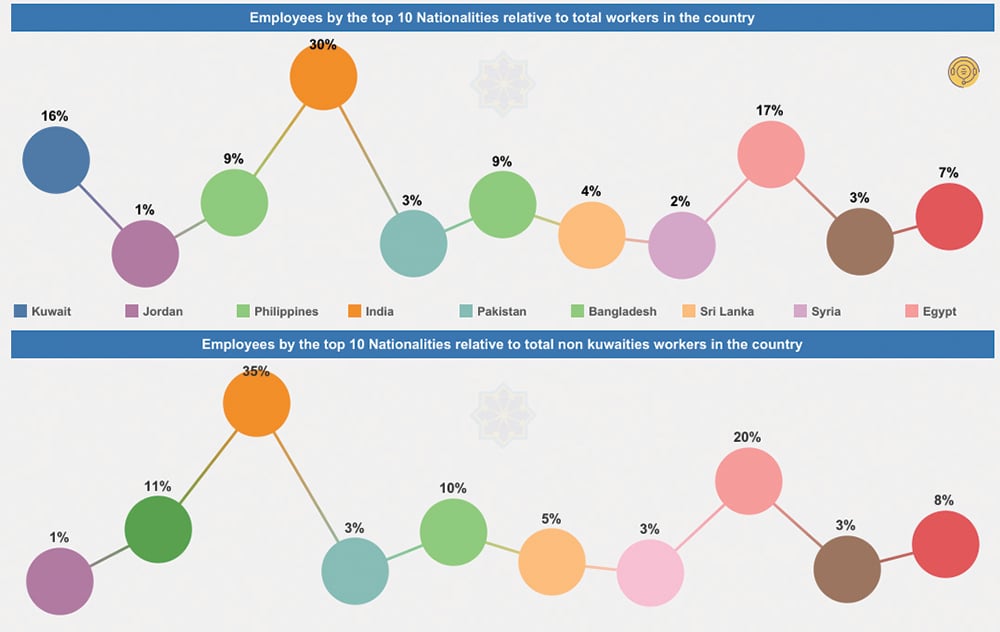By Ahmad Jabr and Nebal Snan
KUWAIT: The proportion of citizens in Kuwait’s labor force dropped to 15.9 percent by the end of 2022 compared to 17.4 percent a year earlier, according to recent government statistics. The change is accompanied by a surge in the number of domestic workers and expatriate workers in the public and private sectors.
The new figures released by the Central Statistical Bureau shed light on the challenges facing Kuwait, as the government seeks to rectify what it describes as a ‘demographic imbalance’ problem that’s often blamed for a host of issues including deteriorating public services. But despite state efforts to reduce the heavy reliance on foreign manpower in favor of encouraging the recruitment of more Kuwaiti workers, the percentage of Kuwaitis has dropped not only in the private sector, but in the public sector as well, according to the statistics.
In the public sector, Kuwaiti employees made up 79.8 percent of the workforce in 2022, slightly down from 80 percent in 2021. Kuwaitis made up only 4.6 percent of private sector employees, also down from 5 percent in 2021. The drop in the percentage of Kuwaiti employees in the public sector is not due to a decrease in their numbers. In fact, the number of both Kuwaiti and non-Kuwaiti workers increased in 2022 compared to 2021. However, Kuwaiti workers increased by 3.6 percent, whereas non-Kuwaiti workers increased by 4.5 percent, meaning more non-Kuwaitis joined the public sector compared to Kuwaitis in 2022.
More domestic helpers
Domestic helpers saw the largest jump in numbers compared to other worker groups, rising from 24 percent of the total workforce in 2021 to 27 percent in 2022. Meanwhile, private sector workers still made up more than half of the total workforce at 56.3 percent by the end of 2022, down from 57.9 percent in 2021. On the other hand, public sector employees made up only 16.7 percent of the total workforce by the end of 2022 compared to 18.1 in 2021.
Kuwait’s total workforce recorded a slight growth in 2022, increasing by 12.7 percent. The country’s overall labor force stood at 2,790,287 by the end of 2022, including 464,606 public sector employees, 1,572,384 private sector employees and 753,297 domestic helpers.
Both Kuwaiti and expatriate labor forces have grown, the statistics show. Kuwaiti employees increased by 2.9 percent, making up 21.7 percent of the total workforce by the end of 2022. Meanwhile, the expatriate workforce rose by 9.8 percent, as their participation level in Kuwait’s labor market reached 78.3 percent. The Kuwaiti workforce stood at 442,647 employees, while expatriate labor reached 1,594,343 as of the end of 2022.
While expatriates remain the dominant workforce in Kuwait’s private sector, the statistics show that more domestic helpers entered the labor market last year compared to expatriate private sector employees. According to the latest figures, 63.9 percent of expatriates worked in the private sector, while 32.1 percent were employed as domestic workers as of the end of 2022, up from 29 percent in 2021, when 66.6 percent of expat laborers worked in the private sector.
Main recruiters
Accommodation and food service activities, construction and manufacturing industries remain the top three business fields where Kuwait’s labor force is concentrated in the private sector, according to the data. More than 72.2 percent of Kuwaitis in the private sector work there, including 52.8 percent in accommodation and food service activities. Meanwhile, companies working in these three fields employ over 70 percent of expatriates in the private sector, including 45.7 percent in accommodation and food service activities alone.
Nationality breakdown
India has the largest workforce in Kuwait at 30 percent of the country’s total laborers, according to data from new population and labor market indicators released by the Public Authority for Civil Information on Monday. Egypt comes second at 17 percent followed by Kuwait at 16 percent and then the Philippines and Bangladesh, which are tied at nine percent each. Among the expatriate workforce, Indians dominate the top percentage with 35 percent, followed by Egypt at 20 percent, the Philippines at 11 percent and Bangladesh at eight percent.











